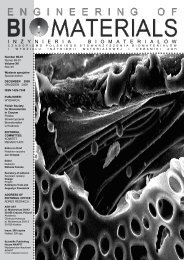69-72 - Polskie Stowarzyszenie BiomateriaÅów
69-72 - Polskie Stowarzyszenie BiomateriaÅów
69-72 - Polskie Stowarzyszenie BiomateriaÅów
You also want an ePaper? Increase the reach of your titles
YUMPU automatically turns print PDFs into web optimized ePapers that Google loves.
wgt% (HAp/matrix) porosity [%] bulk density [g/cm 3 ]<br />
0 14.54 1.18<br />
2 18.03 1.12<br />
5 17.84 1.14<br />
10 15.36 1.19<br />
15 14.30 1.28<br />
20 12.09 1.36<br />
25 14.32 1.32<br />
TABLE 2. The open porosity and apparent density<br />
of composite samples.<br />
References<br />
[1] Ramakrishna, S., Mayer, J., Wintermantel, E. Composite Science<br />
and Technology, 61, 2001. pp. 1189-1224.<br />
[2] Nakamura et al. Journal of Biomedical Materials Research, 19,<br />
1985, pp. 685-<strong>69</strong>8.<br />
[3] Suchy, T., Balík, K., Sochor, M., Černý, M., Hulejová, H. et al. In:<br />
Human Biomechanics 2006 [CD-ROM]. University of Technology,<br />
Brno, 2006, pp. 1-5.<br />
[4] Balik, K., Sochor, M., Suchy, T.Cerny, M., Hulejova, H. In: Journal<br />
of Biomechanics, Abstracts of the 5th World Congress of Biomechanics,<br />
Munich, Germany, Berlin: Elsevier, 2006, p. S264.<br />
ANALYSIS OF A CONTACT<br />
STRESS DISTRIBUTION IN NEW<br />
SHAPE OF A HIP CUP<br />
Jan Sykora*, Svatava Konvickova, Matej Daniel<br />
FIG.3. Flexure strength R fm and flexure modulus<br />
E f of composites with HAp nanopartricles.<br />
Laboratory of Human Biomechanics, Department<br />
of Mechanics, CTU in Prague, Czech Republic<br />
Laboratory of Human Biomechanics, CTU in Prague,<br />
Faculty of Mechanical Engineering, Department of<br />
Mechanics, Technicka 4, 166 07, Prague 6, Czech Republic<br />
*E-mail: J.Sykora@sh.cvut.cz<br />
FIG.4. Pictures of polished cross-section of composite<br />
with 5% HAp (left) and 20% HAp (right)<br />
illustrate multiple cracking in cured matrix with<br />
higher amount of HAp.<br />
of cured matrix (FIG.4). In this case, the matrix seems to<br />
be prone to a brittle failure (becoming more ceramic), which<br />
could lead to a lower resistance to fatigue failure, which is<br />
one of limiting factors for applicability of implant materials.<br />
Conclusions<br />
We obtained flexure strength and flexure modulus<br />
of composites based on aramid fabric and polysiloxane<br />
resin with various amount of HAp nanoparticles additives.<br />
It is important to match the compromise between sufficient<br />
mechanical properties and amount of bioactive additives.<br />
It seems that higher amount of additives should have a<br />
negative influence on mechanical properties. As a further<br />
step it will be necessary to define an amount of additives<br />
more precisely (step 1-2%) and also to compare different<br />
size of particles (nano vs. micro).<br />
Acknowledgements<br />
This study was supported by the Czech Science<br />
Foundation under the project No. 106/06/1576 and by<br />
the Ministry of Education of Czech Republic project<br />
No. MSM 6840770012.<br />
[Engineering of Biomaterials, <strong>69</strong>-<strong>72</strong>, (2007), 2-3]<br />
Introduction<br />
We develop a new design of an acetabular component<br />
for a total replacement of a hip joint. We indicate on the<br />
basis of the comparison our results of mathematical and<br />
finite element models of a contact stress distribution, that it<br />
is possible to use the finite element method for the modeling<br />
of the non-weigh bearing part of the total replacement of<br />
the hip joint. The point of this technical solution of the new<br />
hip cup is to design such a shape of the joint surface that<br />
will be symmetrical towards the hip joint stress. The shape<br />
is designed as the basic mathematical models of the distribution<br />
of the contact stress [1]. Three basic forms of this<br />
shape were designed. The cup with the hole was chose as<br />
the most suitable [2].<br />
Materials and methods<br />
We compared two various finite element models of the<br />
hip cup, cup with hole (A) and cup with hole and fillet edges<br />
(B). The models were loaded by five forces. We got contact<br />
stress distribution between the head and the modified hip<br />
cup. The each of those forces had different value and different<br />
direction of a loading. The forces matched values of a<br />
resultant hip joint force in hip joint in the course of different<br />
movement of a human body.<br />
Results<br />
The resultant contact stress distributions are on the figures<br />
1-5. The resultant contact stress distributions for each<br />
model at loading of a first force are in Figure 1, for second<br />
force in Figure 2, for third force in Figure 3, for fourth<br />
force in Figure 4 and in Figure 5 for last force.













